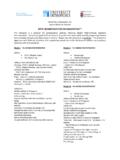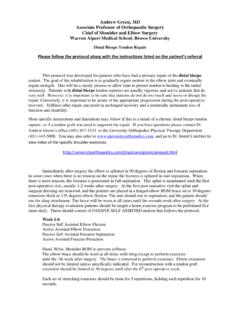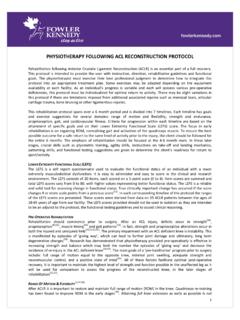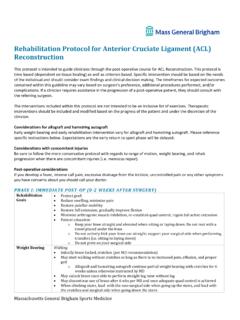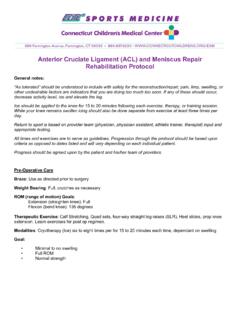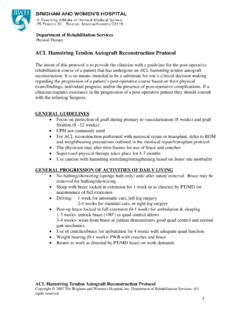Transcription of ANTERIOR CRUCIATE LIGAMENT (ACL) POST-‐OP …
1 1 University Orthopedics, Inc. Sports Medicine Division ANTERIOR CRUCIATE LIGAMENT (ACL) post - OP rehabilitation protocol The following is a protocol for postoperative patients following ACL reconstruction . The primary goal of this protocol is to protect the reconstruction while steadily progressing towards and ultimately achieving pre- injury level of activity. Please note this protocol is a guideline. Patients with additional surgery ( collateral LIGAMENT repair, meniscal repair) will progress at different rates. Achieving the criteria of each phase should be emphasized more than the approximate duration.
2 If a patient should develop an increase in pain or swelling or decrease in motion at any time, activity should be decreased until problems are resolved. PHASE I: 0- 2 WEEKS POSTOPERATIVE GOALS: Progressive decrease in swelling AROM: 0 100 degrees Prevent post - op knee stiffness Independent SLR without an extensor lag WBAT with crutches and brace ACTIVITIES: PROM/AAROM/AROM for knee flexion/extension Heel props, prone hangs, towel extensions for extension Heel and wall slides for flexion, prone knee flexion Isometrics Quad sets (0 degrees knee flexion) Hip adduction (0 and 45 degrees knee flexion) Hamstring sets (45 degrees knee flexion)
3 St raight leg raises All 4 planes With immobilizer until able to SLR without extensor lag Gait training WBAT with crutches and immobilizer until able to ambulate with quad control Pre - gait activities Proprioception Weight shifting with UE support B/L heel raises Standing hip flexion with WB quad set Patella mobilizations Modalities and rest to control pain and inflammation PHASE II: ~2- 4 WEEKS POSTOPERATIVE GOALS: Continued progressive decrease in swelling Full AROM knee flexion and extension Independent ambulation without gait deviation ACTIVITIES: AROM/AAROM/PROM to maintain full knee extension and progress flexion Functional strengthening OKC exercises: SLR (all 4 planes, progressive resistance), prone ham curls (knee 2 off table, light theraband resistance), SAQ extensions at 90 30 degrees CKC exercises: Wall sits (30 degree forward lean, squeezing ball), squats, 2 4 step- ups Stationary bike (no resistance) Gait training / Proprioception Treadmill: Retro- walking and forward walk ing Heel and toe walking Sidestepping Cup- walking : walking and sidestepping over 16 oz.
4 Plastic cups Standing hip and knee flexion Unilateral heel raises Modalities as needed to control pain and inflammation 2 PHASE III: ~4- 8 WEEKS POSTOPERATIVE GOALS: Swelling <1 cm at knee joint line Symmetrical prone ROM Pain free 6 step down with good eccentric control ACTIVITIES: Progressive functional strengthening Multi- hip/cable column for hip strengthening Prone hamstring curls with progressive re sistance Squats with minimal resistance (standing on theraband and/or light barbell) Lunges 4 6 step- ups, step- downs Single leg press (<25% BW @ 4 6 weeks.)
5 <50% BW @ 6 8 weeks post - op) Stationary bike, treadmill Stairmaster (approximately 6 weeks post - op if no patellofemoral symptoms) Proprioception BAPS, Rocker board Unistands (floor and mini tramp) Maintain full ROM Modalities as needed to control pain and inflammation AT THIS POINT, SOME PATIENTS MAY HAVE USED UP THEIR ALLOWABLE BENEFITS FROM THEIR INSURANCE COMPANY. HOWEVER, THIS DOES NOT MEAN THE PATIENT IS DONE WITH THEIR rehabilitation . THE THERAPIST WILL WORK WITH THE PATIENT TO HELP SET UP A PROGESSIVE HOME EXERCISE PROGRAM IF IT IS NECESSARY. IT IS RECOMMENDED THE PATIENT JOIN A HEALTH CLUB/GYM AT THIS POINT TO MAXIMIZE REHAB POTENTIAL.
6 PHASE IV: ~8- 12 WEEKS POSTOPERATIVE GOALS: Pain /effusion free Symmetrical ROM Single leg press 70% of noninvolved extremity with 1 rep max Girth within 2 cm of non- involved extremity ACTIVITIES: Advanced CKC strengthening: Leg press (unilateral and bilateral) Squats: bilateral with barbell, unilateral with theraband Lunges: backward, side and traveling lunges; lunges with plyoball overhead Bike, stairmaster with progressive increase in resistance Proprioception: Plus outline on mini tramp and/or floor: Jumping (approximately 12 16 weeks post - op) Hopping (approximately 16 20 weeks post - op) PHASE V: 12 Weeks to 6 Months Average person and recreational athlete: At 50% of normal function.
7 Continue with a strengthening program a minimum of 3 times per week for 6 months Recreational athlete should also participate in some light agility training to prepare for return to sport phase of rehab. High- level athlete: Progressive running program if the above criteria have been met. Cross train biking and pool activities. Focus on progressive strengthening, running, plyometric and pre- sport activities for preparation for the return to sport phase of rehab. PHASE VI (6 Months 9 Months) CRITERIA FOR RETURN TO SPORTS (APPROXIMATELY 6 - 9 MONTHS post - OP): 1. Pain free 2. Symmetrical ROM 3.
8 No effusion 4. Quad Index > 90% 5. Single leg press equal bilateral with 1 rep max test 6. Jogging 2 miles pain free 7. Functional hop testing 90% of non- involved extremity 8. Y- Balance Test: composite score > 90% 9. Functional bracing discussion 10. Discussion with patient about confidence to RTS


